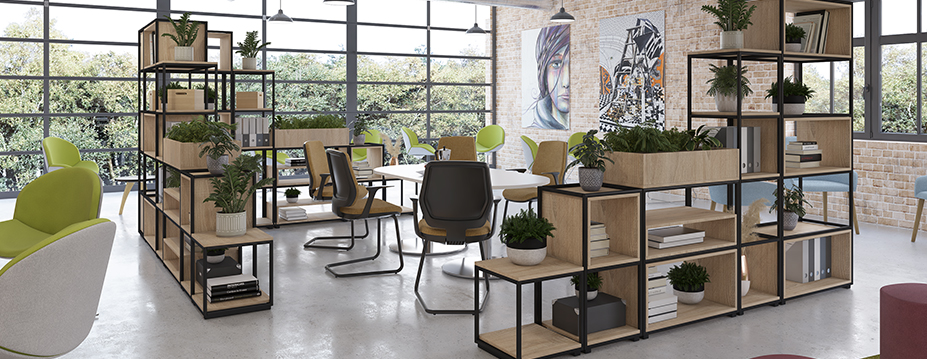The pandemic and working from home have reinstated our desire for comfort and most workers don’t want to lose that when returning to the office. Because of this, many businesses are reconsidering how an office should be set up, what it should offer, and what employees are looking for. So, how would you go about making the office feel more cosy, comfortable and welcoming?

Domestic touches have become increasingly popular in workplace design, further blurring the lines between work and home life. The approach is to make people feel more at ease at work, to help people feel more satisfied and calm, which is important for productivity and general happiness. This idea may be implemented in the workplace by modifying the layout, providing facilities, and revising regulations or allowances. Employees will be more relaxed and remain longer if these aspects are added to the workplace.
Look at the style of an office in any given era and you’ll get a glimpse of the defining themes in white-collar worker’s lives at the time. During the latter part of the 20th century, most office workers wore suits, and many workplaces were sleek, serious, and formal. These days however, most workplaces are much more casual, inviting and familiar, but their design is no less revealing. Lately, many offices have started to look distinctly less like offices and more like homes. But how do you go about incorporating domestic touches into the workplace?
Natural elements
Natural surroundings have a relaxing influence on people. Stress, noise, and air toxins reduce with the presence of plants in the workplace. Businesses should consider incorporating wooden elements, earthy tones, and greenery into the workplace decor. Bringing the outdoors inside will help employees feel more calm at work as it will give the impression that their workplace has been created with wellbeing in mind. The use of neutral hues such as grey, white, and creams also has a calming impact.
Natural office lighting is another one of the determining factors between a comfortable environment and a stressful one. Lighting has a significant influence on our physical and mental wellbeing and the perfect lighting for a workspace would be softer and warmer, causing no headaches or eye strain. It also boosts wellness and happiness while improving attention and work effectiveness.
Cosy workspaces
Creating workspaces that resemble a living room is an excellent way to embrace a homely atmosphere at work. To take a break from the conventional desk-based allocated seating we've all been accustomed to, create pleasant spaces with sofas, lots of cushions, and decorative floor lamps. Comfortable chairs, rugs, and open shelving instead of the standard bookcases can also be included.
The Flux modular open shelving system from Dams epitomises the future of adaptable, modern design. Flux has a capacitor for an infinite number of layout options and shapes to help create work zones in any space to promote privacy or transparency as needed. The crisp, clean aesthetic of the black frame has a domestic look and feel to break up the workplace landscape, while bringing together a wide range of complementary components including wooden add-ons and planter boxes to add some greenery to the workplace for a biophilic appearance.
The downside
These improvements to the office environment may instantly make it more appealing and comfortable for some employees, but they’re not for everyone. Even before the coronavirus pandemic, work and home had gotten uncomfortably mushed together for office workers. And with the rise of remote work for this population over the past 2 years, they have only become more so. Bringing domestic design into offices may well be conducive to work, but this merging of aesthetics can feel unavoidably strange. More subtly, making work look more like home could disturb people’s sense of separation between those two aspects of their lives.
Many of the people who have come to prefer remote work will not be swayed by a sofa and a few cushions, no matter how tasteful. In a survey last year by the remote-work job site FlexJobs, the two most popular answers to the question of what respondents most liked about working from home were not having to commute, and spending less money on things like food and fuel. Some things simply can’t be designed into an office, and for this reason, a hybrid working model of partially remote, partially in-person work is what many companies are now considering. That way, workers wouldn’t have to give up these benefits entirely.
In conclusion
Incorporating home comforts into the working life may give the workplace a unique feel. However businesses should consider the company culture as well as the personalities of their employees before implementing. Employees may feel more calm at work if their workplace is created with wellbeing in mind, helping them to relax, de-stress and improve moods.
Employers that favour it hope that a more charming and comfortable physical space might help attract talented workers and help their employees do better work and collaborate better. And while the aspects of home that can be replicated at work do look and feel nice, they ultimately serve business needs.
Of course, for workers who are expected to be constantly online, the border between work and home has been eroding for a long time. And in that respect, homey offices are more a symptom than a cause. In the possible near future when hybrid arrangements become normal and many workers split their time between home-like offices and office-like homes, the distinction between work and home life may become almost meaningless.